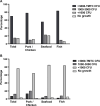Identification of bacteria on Thai banknotes and coins using MALDI-TOF mass spectrometry and their phenotypic antimicrobial susceptibility profiles
- PMID: 40416613
- PMCID: PMC12101445
- DOI: 10.7717/peerj.19465
Identification of bacteria on Thai banknotes and coins using MALDI-TOF mass spectrometry and their phenotypic antimicrobial susceptibility profiles
Abstract
Background: The existence and transmission of pathogenic and antibiotic-resistant bacteria through currency banknotes and coins poses a global public health risk. Banknotes and coins are handled by people in everyday life and have been identified as a universal medium for potentially microbial contamination.
Methods: To ascertain existence of medically important bacteria, a total of 300 samples including 150 banknotes and 150 coins were randomly collected at onsite retail fresh meat stores, i.e., pork and chicken, fish, and seafood stores, from nineteen fresh markets distributed across Bangkok, Thailand. An individual banknote or coin was entirely swabbed, and bacterial culture was carried out using tryptic soy agar (TSA), sheep blood agar (SBA) and MacConkey agar (Mac). A colony count was performed and bacterial species identification was conducted using matrix-assisted laser desorption/ionization (MALDI)-time of flight (TOF) mass spectrometry. Phenotypic antimicrobial susceptibility testing was carried out using the Kirby-Bauer disc diffusion methods.
Results: The results demonstrated that the bacterial contamination rate was higher on banknotes than on coins (93.33% vs. 30.00%) in all three store types. A substantial number of colonies of >3,000 colony forming units (CFU) was predominantly found in banknotes (70.00%), especially from fish store (83.3%); meanwhile, <1,000 CFU was observed in coin sample (76.67%). MALDI-TOF mass spectrometry could identify 107 bacterial species, most of them were Staphylococcus kloosii (14.02%, 15/107), Staphylococcus saprophyticus (12.15%, 13/107), and Macrococcus caseolyticus (8.41%, 9/107). The prevalence based on genera were Staphylococcus (36.45%, 39/107), Acinetobacter (20.56%, 22/107), and Macrococcus (10.28%, 11/107). Almost all Staphylococcus isolates had low susceptibility to penicillin (21%). Notably, Staphylococcus arlettae, Staphylococcus haemolyticus and M. caseolyticus were multidrug-resistant (MDR). It is notable that none of the staphylococci and macrococci isolates exhibited inducible clindamycin resistance (D-test negative). Escherichia coli and Pseudomonas putida isolates were carbapenem-resistant, and Acinetobacter baumannii isolates were MDR with showing carbapenem resistance.
Conclusion: Our data demonstrated a high prevalence of medically important bacteria presented on Thai currency, which may pose a potential risk to human health and food safety. Food vendors and consumers should be educated about the possible cross-contamination of bacteria between the environment, food item, and currency.
Keywords: Antimicrobial susceptibility test; Bacteria; Currency; MALDI-TOF mass spectrometry; Markets; Thai.
©2025 Niyomdecha et al.
Conflict of interest statement
The authors declare there are no competing interests.
Figures




Similar articles
-
Rapid antimicrobial susceptibility testing by matrix-assisted laser desorption ionization-time of flight mass spectrometry using a qualitative method in Acinetobacter baumannii complex.J Microbiol Methods. 2018 Oct;153:60-65. doi: 10.1016/j.mimet.2018.09.002. Epub 2018 Sep 5. J Microbiol Methods. 2018. PMID: 30193924
-
Effects of solid-medium type on routine identification of bacterial isolates by use of matrix-assisted laser desorption ionization-time of flight mass spectrometry.J Clin Microbiol. 2012 Mar;50(3):1008-13. doi: 10.1128/JCM.05209-11. Epub 2011 Dec 7. J Clin Microbiol. 2012. PMID: 22162546 Free PMC article.
-
Rapid Identification of Staphylococcus Species Isolated from Food Samples by Matrix-Assisted Laser Desorption/Ionization Time-of-Flight Mass Spectrometry.J Microbiol Biotechnol. 2019 Apr 28;29(4):548-557. doi: 10.4014/jmb.1901.01046. J Microbiol Biotechnol. 2019. PMID: 30939633
-
Machine learning for microbial identification and antimicrobial susceptibility testing on MALDI-TOF mass spectra: a systematic review.Clin Microbiol Infect. 2020 Oct;26(10):1310-1317. doi: 10.1016/j.cmi.2020.03.014. Epub 2020 Mar 23. Clin Microbiol Infect. 2020. PMID: 32217160
-
Matrix assisted laser desorption time of flight mass spectrometry (MALDI-TOF MS) in clinical microbiology.J Microbiol Methods. 2017 Jul;138:20-29. doi: 10.1016/j.mimet.2016.09.003. Epub 2016 Sep 6. J Microbiol Methods. 2017. PMID: 27613479 Review.
References
-
- Agersew A. Microbial contamination of currency notes and coins in circulation: a potential public health hazard. Biomedicine and Biotechnology. 2014;2(3):46–53.
-
- Alemu A. Microbial contamination of currency notes and coins in circulation: a potential public health hazard. Biomedicine and Biotechnology. 2014;2:46–53.
MeSH terms
Substances
LinkOut - more resources
Full Text Sources
Research Materials

